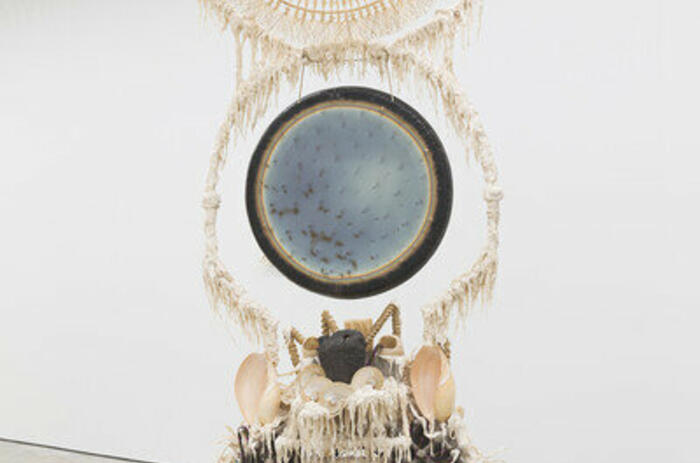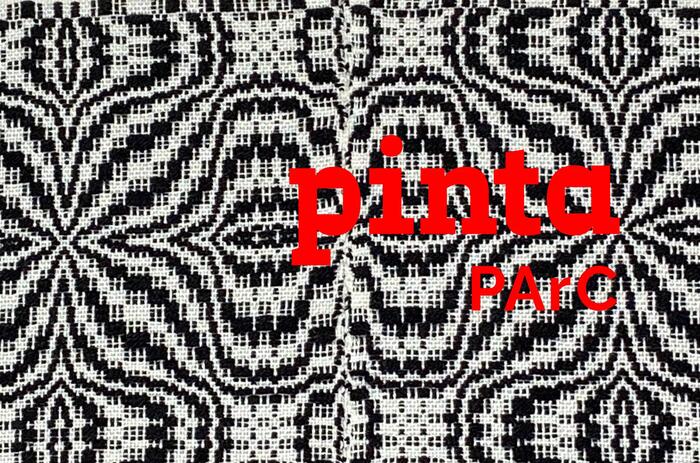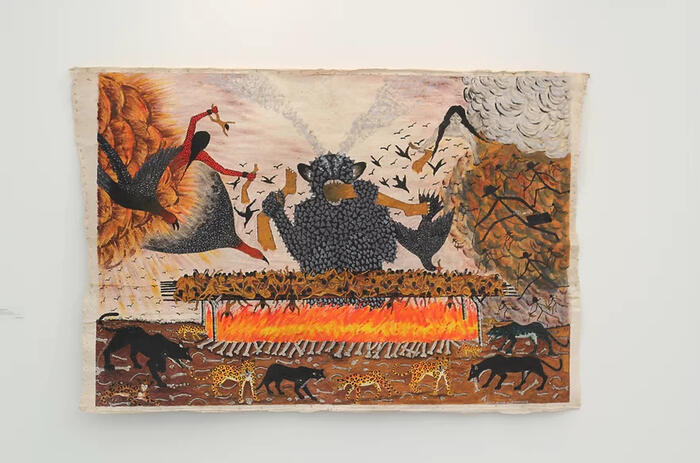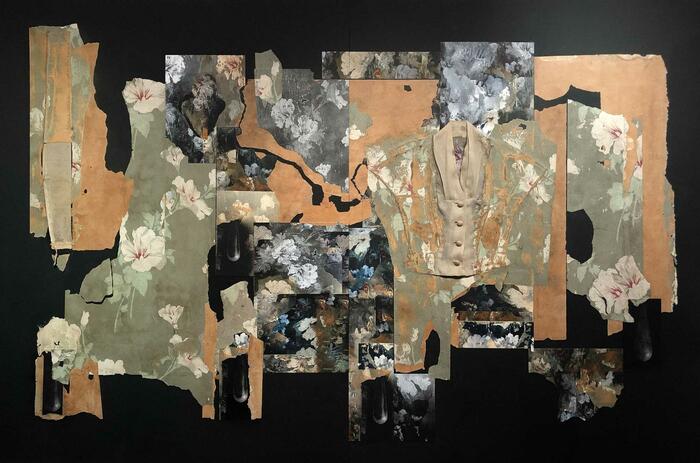TERESA LANCETA: WEAVING AS OPEN SOURCE
The exhibition Teresa Lanceta: Weaving as Open Source traces the artist's trajectory from the 1970s through to the present day and includes a broad selection of tapestries, weavings, fabrics, drawings, photographs and videos, offering the most comprehensive overview of her work to date. The exhibition traces a narrative through various series of projects with the aim of identifying Lanceta's voice, and presents works that poetically question concepts formerly considered antagonistic.

The exhibition Teresa Lanceta: Weaving as Open Source traces the artist's trajectory from the 1970s through to the present day and includes a broad selection of tapestries, weavings, fabrics, drawings, photographs and videos, offering a comprehensive overview of her work. The exhibition traces a narrative through various series of projects with the aim of identifying Lanceta's voice, and presents works that poetically question concepts formerly considered antagonistic.
For Teresa Lanceta, the act of weaving constitutes a triggering of critical imagination beyond the confines of materiality. For her, weaving is an open-source formula of rupture and repetition, from which it is possible to read, transform and convey a knowledge that is always complex and plural. Moreover, she conceives weaving as a "technical" knowledge dependent on a specific geographical, cultural and human context, be it, in her case, Barcelona's Raval neighbourhood, where she lived, or the Middle Atlas, which she visited every year for three decades. Both of these places fed her fascination for women's work and the non-verbal communication of stories and emotional bonds.
It also explores Lanceta's interest in collaborative work formats based around dialogues she establishes with the help of "creative accomplices," including Olga Diego, Pedro G. Romero and Xabier Salaberria; the curator Leire Vergara; the collective La Trinxera; the filmmaker Virginia García del Pino; the artist and thinker Nicolas Malevé who, together with members of the Museum's Education Department and pupils and teachers from Miquel Tarradell secondary school, has spent the last few years developing the project "The Trades in the Raval."
Lanceta's practice reveals the construction of a popular narrative recalling that described by Annie Albers in her book On Weaving (1965), written after her journeys through various Mexican communities. Like Albers in Monte Albán (Oaxaca), Lanceta found in the Middle Atlas traditional techniques with which she identified, techniques that looked to the popular crafts of the present, to the inherited, to the everyday world of the senses and to a possible material representation of the unfathomable.
Accompanying the exhibition, a series of activities, visits and seminars will be presented by many of Lanceta's "creative accomplices," such as the cycle of discussions "Let's talk..." and the "Hosts" project, a series of group conversations in the exhibition galleries hosted by the pupils of the project "The Trades in the Raval."
Teresa Lanceta: Weaving as Open Source
Until September 11, 2022
Museu d'Art Contemporani de Barcelona (MACBA)
Related Topics
May interest you

The exhibition Tierra Blanca Joven at the Brooklyn Museum, draws from the artist’s own experiences as an undocumented immigrant and cancer survivor to weave together themes of displacement, illness, recovery, and healing in new and existing works; objects from the Museum’s Maya art collection; and a Healing Room.
GUADALUPE MARAVILLA: TIERRA BLANCA JOVEN
The exhibition Tierra Blanca Joven at the Brooklyn Museum, draws from the artist’s own experiences as an undocumented immigrant and cancer survivor to weave together themes of displacement, illness, recovery, and healing in new and existing works; objects from the Museum’s Maya art collection; and a Healing Room.

The exhibition Tierra Blanca Joven at the Brooklyn Museum, draws from the artist’s own experiences as an undocumented immigrant and cancer survivor to weave together themes of displacement, illness, recovery, and healing in new and existing works; objects from the Museum’s Maya art collection; and a Healing Room.
GUADALUPE MARAVILLA: TIERRA BLANCA JOVEN
The exhibition Tierra Blanca Joven at the Brooklyn Museum, draws from the artist’s own experiences as an undocumented immigrant and cancer survivor to weave together themes of displacement, illness, recovery, and healing in new and existing works; objects from the Museum’s Maya art collection; and a Healing Room.

As a novelty, this year Pinta PArC presents a new space with a leading role marked by the textile art of Tiodoro Pacco. Institutionally and with the curatorship of Jerson Ramirez, the aim is to recover, highlight and celebrate the traditional techniques and artistic work of the region. The space is thus dedicated to the exploration of memory, the transmission of cultural valuesand the examination of the processes and formats that are interwoven in the Peruvian artistic identity.
CONTEMPORARY TRADITION - TEXTILE ART AT PINTA PARC 2022
As a novelty, this year Pinta PArC presents a new space with a leading role marked by the textile art of Tiodoro Pacco. Institutionally and with the curatorship of Jerson Ramirez, the aim is to recover, highlight and celebrate the traditional techniques and artistic work of the region. The space is thus dedicated to the exploration of memory, the transmission of cultural valuesand the examination of the processes and formats that are interwoven in the Peruvian artistic identity.

Pinacoteca de São Paulo presents Adriana Varejão: Sutures, Fissures, Ruins, a retrospective exhibition by Adriana Varejão (Rio de Janeiro, 1964). Curated by Jochen Volz, the museum’s general director, the show proposes a narrative that highlights the diversity and complexity of her production.
ADRIANA VAREJÃO: SUTURES, FISSURES, RUINS
Pinacoteca de São Paulo presents Adriana Varejão: Sutures, Fissures, Ruins, a retrospective exhibition by Adriana Varejão (Rio de Janeiro, 1964). Curated by Jochen Volz, the museum’s general director, the show proposes a narrative that highlights the diversity and complexity of her production.

Another Space announces Elsewhere(s), an exploration of otherworldliness. Cocurated by Estrellita B. Brodsky and José Falconi, the exhibition brings together works by over 25 artists from Latin America and its diaspora, from the 9th Century BCE to the present. Grouped around themes of cosmology, magic, and non-Western forms of knowledge, Elsewhere(s) seeks to reflect on the traditional role of artists and their potential to envision alternative societies as utopian or reclaimed territories.
ELSEWHERE(S): OTHER WORLDS, OTHER TIMES, OTHER TERRITORIES
Another Space announces Elsewhere(s), an exploration of otherworldliness. Cocurated by Estrellita B. Brodsky and José Falconi, the exhibition brings together works by over 25 artists from Latin America and its diaspora, from the 9th Century BCE to the present. Grouped around themes of cosmology, magic, and non-Western forms of knowledge, Elsewhere(s) seeks to reflect on the traditional role of artists and their potential to envision alternative societies as utopian or reclaimed territories.

The Bass presents AbsenceRevealed, an exhibition featuring a new series of works by experimental photo-based artist Maria Martínez-Cañas on view through October 23, 2022.
MARÍA MARTÍNEZ-CAÑAS: ABSENCE REVEALED
The Bass presents AbsenceRevealed, an exhibition featuring a new series of works by experimental photo-based artist Maria Martínez-Cañas on view through October 23, 2022.

The exhibition Tierra Blanca Joven at the Brooklyn Museum, draws from the artist’s own experiences as an undocumented immigrant and cancer survivor to weave together themes of displacement, illness, recovery, and healing in new and existing works; objects from the Museum’s Maya art collection; and a Healing Room.
GUADALUPE MARAVILLA: TIERRA BLANCA JOVEN
The exhibition Tierra Blanca Joven at the Brooklyn Museum, draws from the artist’s own experiences as an undocumented immigrant and cancer survivor to weave together themes of displacement, illness, recovery, and healing in new and existing works; objects from the Museum’s Maya art collection; and a Healing Room.

As a novelty, this year Pinta PArC presents a new space with a leading role marked by the textile art of Tiodoro Pacco. Institutionally and with the curatorship of Jerson Ramirez, the aim is to recover, highlight and celebrate the traditional techniques and artistic work of the region. The space is thus dedicated to the exploration of memory, the transmission of cultural valuesand the examination of the processes and formats that are interwoven in the Peruvian artistic identity.
CONTEMPORARY TRADITION - TEXTILE ART AT PINTA PARC 2022
As a novelty, this year Pinta PArC presents a new space with a leading role marked by the textile art of Tiodoro Pacco. Institutionally and with the curatorship of Jerson Ramirez, the aim is to recover, highlight and celebrate the traditional techniques and artistic work of the region. The space is thus dedicated to the exploration of memory, the transmission of cultural valuesand the examination of the processes and formats that are interwoven in the Peruvian artistic identity.

Pinacoteca de São Paulo presents Adriana Varejão: Sutures, Fissures, Ruins, a retrospective exhibition by Adriana Varejão (Rio de Janeiro, 1964). Curated by Jochen Volz, the museum’s general director, the show proposes a narrative that highlights the diversity and complexity of her production.
ADRIANA VAREJÃO: SUTURES, FISSURES, RUINS
Pinacoteca de São Paulo presents Adriana Varejão: Sutures, Fissures, Ruins, a retrospective exhibition by Adriana Varejão (Rio de Janeiro, 1964). Curated by Jochen Volz, the museum’s general director, the show proposes a narrative that highlights the diversity and complexity of her production.

Another Space announces Elsewhere(s), an exploration of otherworldliness. Cocurated by Estrellita B. Brodsky and José Falconi, the exhibition brings together works by over 25 artists from Latin America and its diaspora, from the 9th Century BCE to the present. Grouped around themes of cosmology, magic, and non-Western forms of knowledge, Elsewhere(s) seeks to reflect on the traditional role of artists and their potential to envision alternative societies as utopian or reclaimed territories.
ELSEWHERE(S): OTHER WORLDS, OTHER TIMES, OTHER TERRITORIES
Another Space announces Elsewhere(s), an exploration of otherworldliness. Cocurated by Estrellita B. Brodsky and José Falconi, the exhibition brings together works by over 25 artists from Latin America and its diaspora, from the 9th Century BCE to the present. Grouped around themes of cosmology, magic, and non-Western forms of knowledge, Elsewhere(s) seeks to reflect on the traditional role of artists and their potential to envision alternative societies as utopian or reclaimed territories.

The Bass presents AbsenceRevealed, an exhibition featuring a new series of works by experimental photo-based artist Maria Martínez-Cañas on view through October 23, 2022.
MARÍA MARTÍNEZ-CAÑAS: ABSENCE REVEALED
The Bass presents AbsenceRevealed, an exhibition featuring a new series of works by experimental photo-based artist Maria Martínez-Cañas on view through October 23, 2022.

The exhibition Tierra Blanca Joven at the Brooklyn Museum, draws from the artist’s own experiences as an undocumented immigrant and cancer survivor to weave together themes of displacement, illness, recovery, and healing in new and existing works; objects from the Museum’s Maya art collection; and a Healing Room.
GUADALUPE MARAVILLA: TIERRA BLANCA JOVEN
The exhibition Tierra Blanca Joven at the Brooklyn Museum, draws from the artist’s own experiences as an undocumented immigrant and cancer survivor to weave together themes of displacement, illness, recovery, and healing in new and existing works; objects from the Museum’s Maya art collection; and a Healing Room.

As a novelty, this year Pinta PArC presents a new space with a leading role marked by the textile art of Tiodoro Pacco. Institutionally and with the curatorship of Jerson Ramirez, the aim is to recover, highlight and celebrate the traditional techniques and artistic work of the region. The space is thus dedicated to the exploration of memory, the transmission of cultural valuesand the examination of the processes and formats that are interwoven in the Peruvian artistic identity.
CONTEMPORARY TRADITION - TEXTILE ART AT PINTA PARC 2022
As a novelty, this year Pinta PArC presents a new space with a leading role marked by the textile art of Tiodoro Pacco. Institutionally and with the curatorship of Jerson Ramirez, the aim is to recover, highlight and celebrate the traditional techniques and artistic work of the region. The space is thus dedicated to the exploration of memory, the transmission of cultural valuesand the examination of the processes and formats that are interwoven in the Peruvian artistic identity.

Pinacoteca de São Paulo presents Adriana Varejão: Sutures, Fissures, Ruins, a retrospective exhibition by Adriana Varejão (Rio de Janeiro, 1964). Curated by Jochen Volz, the museum’s general director, the show proposes a narrative that highlights the diversity and complexity of her production.
ADRIANA VAREJÃO: SUTURES, FISSURES, RUINS
Pinacoteca de São Paulo presents Adriana Varejão: Sutures, Fissures, Ruins, a retrospective exhibition by Adriana Varejão (Rio de Janeiro, 1964). Curated by Jochen Volz, the museum’s general director, the show proposes a narrative that highlights the diversity and complexity of her production.

Another Space announces Elsewhere(s), an exploration of otherworldliness. Cocurated by Estrellita B. Brodsky and José Falconi, the exhibition brings together works by over 25 artists from Latin America and its diaspora, from the 9th Century BCE to the present. Grouped around themes of cosmology, magic, and non-Western forms of knowledge, Elsewhere(s) seeks to reflect on the traditional role of artists and their potential to envision alternative societies as utopian or reclaimed territories.
ELSEWHERE(S): OTHER WORLDS, OTHER TIMES, OTHER TERRITORIES
Another Space announces Elsewhere(s), an exploration of otherworldliness. Cocurated by Estrellita B. Brodsky and José Falconi, the exhibition brings together works by over 25 artists from Latin America and its diaspora, from the 9th Century BCE to the present. Grouped around themes of cosmology, magic, and non-Western forms of knowledge, Elsewhere(s) seeks to reflect on the traditional role of artists and their potential to envision alternative societies as utopian or reclaimed territories.

The Bass presents AbsenceRevealed, an exhibition featuring a new series of works by experimental photo-based artist Maria Martínez-Cañas on view through October 23, 2022.
MARÍA MARTÍNEZ-CAÑAS: ABSENCE REVEALED
The Bass presents AbsenceRevealed, an exhibition featuring a new series of works by experimental photo-based artist Maria Martínez-Cañas on view through October 23, 2022.

The exhibition Tierra Blanca Joven at the Brooklyn Museum, draws from the artist’s own experiences as an undocumented immigrant and cancer survivor to weave together themes of displacement, illness, recovery, and healing in new and existing works; objects from the Museum’s Maya art collection; and a Healing Room.
GUADALUPE MARAVILLA: TIERRA BLANCA JOVEN
The exhibition Tierra Blanca Joven at the Brooklyn Museum, draws from the artist’s own experiences as an undocumented immigrant and cancer survivor to weave together themes of displacement, illness, recovery, and healing in new and existing works; objects from the Museum’s Maya art collection; and a Healing Room.

As a novelty, this year Pinta PArC presents a new space with a leading role marked by the textile art of Tiodoro Pacco. Institutionally and with the curatorship of Jerson Ramirez, the aim is to recover, highlight and celebrate the traditional techniques and artistic work of the region. The space is thus dedicated to the exploration of memory, the transmission of cultural valuesand the examination of the processes and formats that are interwoven in the Peruvian artistic identity.
CONTEMPORARY TRADITION - TEXTILE ART AT PINTA PARC 2022
As a novelty, this year Pinta PArC presents a new space with a leading role marked by the textile art of Tiodoro Pacco. Institutionally and with the curatorship of Jerson Ramirez, the aim is to recover, highlight and celebrate the traditional techniques and artistic work of the region. The space is thus dedicated to the exploration of memory, the transmission of cultural valuesand the examination of the processes and formats that are interwoven in the Peruvian artistic identity.

Pinacoteca de São Paulo presents Adriana Varejão: Sutures, Fissures, Ruins, a retrospective exhibition by Adriana Varejão (Rio de Janeiro, 1964). Curated by Jochen Volz, the museum’s general director, the show proposes a narrative that highlights the diversity and complexity of her production.
ADRIANA VAREJÃO: SUTURES, FISSURES, RUINS
Pinacoteca de São Paulo presents Adriana Varejão: Sutures, Fissures, Ruins, a retrospective exhibition by Adriana Varejão (Rio de Janeiro, 1964). Curated by Jochen Volz, the museum’s general director, the show proposes a narrative that highlights the diversity and complexity of her production.

Another Space announces Elsewhere(s), an exploration of otherworldliness. Cocurated by Estrellita B. Brodsky and José Falconi, the exhibition brings together works by over 25 artists from Latin America and its diaspora, from the 9th Century BCE to the present. Grouped around themes of cosmology, magic, and non-Western forms of knowledge, Elsewhere(s) seeks to reflect on the traditional role of artists and their potential to envision alternative societies as utopian or reclaimed territories.
ELSEWHERE(S): OTHER WORLDS, OTHER TIMES, OTHER TERRITORIES
Another Space announces Elsewhere(s), an exploration of otherworldliness. Cocurated by Estrellita B. Brodsky and José Falconi, the exhibition brings together works by over 25 artists from Latin America and its diaspora, from the 9th Century BCE to the present. Grouped around themes of cosmology, magic, and non-Western forms of knowledge, Elsewhere(s) seeks to reflect on the traditional role of artists and their potential to envision alternative societies as utopian or reclaimed territories.

The Bass presents AbsenceRevealed, an exhibition featuring a new series of works by experimental photo-based artist Maria Martínez-Cañas on view through October 23, 2022.
MARÍA MARTÍNEZ-CAÑAS: ABSENCE REVEALED
The Bass presents AbsenceRevealed, an exhibition featuring a new series of works by experimental photo-based artist Maria Martínez-Cañas on view through October 23, 2022.

The exhibition Tierra Blanca Joven at the Brooklyn Museum, draws from the artist’s own experiences as an undocumented immigrant and cancer survivor to weave together themes of displacement, illness, recovery, and healing in new and existing works; objects from the Museum’s Maya art collection; and a Healing Room.
GUADALUPE MARAVILLA: TIERRA BLANCA JOVEN
The exhibition Tierra Blanca Joven at the Brooklyn Museum, draws from the artist’s own experiences as an undocumented immigrant and cancer survivor to weave together themes of displacement, illness, recovery, and healing in new and existing works; objects from the Museum’s Maya art collection; and a Healing Room.

As a novelty, this year Pinta PArC presents a new space with a leading role marked by the textile art of Tiodoro Pacco. Institutionally and with the curatorship of Jerson Ramirez, the aim is to recover, highlight and celebrate the traditional techniques and artistic work of the region. The space is thus dedicated to the exploration of memory, the transmission of cultural valuesand the examination of the processes and formats that are interwoven in the Peruvian artistic identity.
CONTEMPORARY TRADITION - TEXTILE ART AT PINTA PARC 2022
As a novelty, this year Pinta PArC presents a new space with a leading role marked by the textile art of Tiodoro Pacco. Institutionally and with the curatorship of Jerson Ramirez, the aim is to recover, highlight and celebrate the traditional techniques and artistic work of the region. The space is thus dedicated to the exploration of memory, the transmission of cultural valuesand the examination of the processes and formats that are interwoven in the Peruvian artistic identity.

Pinacoteca de São Paulo presents Adriana Varejão: Sutures, Fissures, Ruins, a retrospective exhibition by Adriana Varejão (Rio de Janeiro, 1964). Curated by Jochen Volz, the museum’s general director, the show proposes a narrative that highlights the diversity and complexity of her production.
ADRIANA VAREJÃO: SUTURES, FISSURES, RUINS
Pinacoteca de São Paulo presents Adriana Varejão: Sutures, Fissures, Ruins, a retrospective exhibition by Adriana Varejão (Rio de Janeiro, 1964). Curated by Jochen Volz, the museum’s general director, the show proposes a narrative that highlights the diversity and complexity of her production.

Another Space announces Elsewhere(s), an exploration of otherworldliness. Cocurated by Estrellita B. Brodsky and José Falconi, the exhibition brings together works by over 25 artists from Latin America and its diaspora, from the 9th Century BCE to the present. Grouped around themes of cosmology, magic, and non-Western forms of knowledge, Elsewhere(s) seeks to reflect on the traditional role of artists and their potential to envision alternative societies as utopian or reclaimed territories.
ELSEWHERE(S): OTHER WORLDS, OTHER TIMES, OTHER TERRITORIES
Another Space announces Elsewhere(s), an exploration of otherworldliness. Cocurated by Estrellita B. Brodsky and José Falconi, the exhibition brings together works by over 25 artists from Latin America and its diaspora, from the 9th Century BCE to the present. Grouped around themes of cosmology, magic, and non-Western forms of knowledge, Elsewhere(s) seeks to reflect on the traditional role of artists and their potential to envision alternative societies as utopian or reclaimed territories.

The Bass presents AbsenceRevealed, an exhibition featuring a new series of works by experimental photo-based artist Maria Martínez-Cañas on view through October 23, 2022.
MARÍA MARTÍNEZ-CAÑAS: ABSENCE REVEALED
The Bass presents AbsenceRevealed, an exhibition featuring a new series of works by experimental photo-based artist Maria Martínez-Cañas on view through October 23, 2022.




